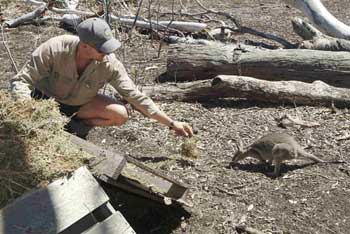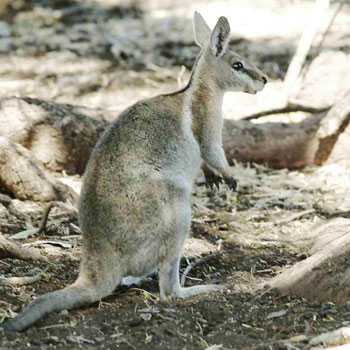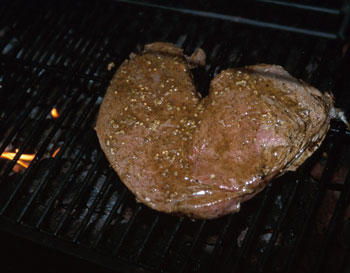Mad over kangaroos
by Jack Kearney
Hunter 9
 One way or the other, as Australians we should all love our roos. These incredible animals are unique in many ways and exemplify this vast, unusual continent with their ability to survive in diverse and extreme conditions. They look fantastic, they are biologically bizarre, it is estimated they attract more than one billion dollars per annum to the economy and last but not least, they taste wonderful marinated in chilli and cooked medium-rare on a barbecue.
One way or the other, as Australians we should all love our roos. These incredible animals are unique in many ways and exemplify this vast, unusual continent with their ability to survive in diverse and extreme conditions. They look fantastic, they are biologically bizarre, it is estimated they attract more than one billion dollars per annum to the economy and last but not least, they taste wonderful marinated in chilli and cooked medium-rare on a barbecue.
That last statement leads me nicely into the rest of the discussion. It is easy to understand why so many people are mad over roos. Perhaps because they’re cute and cuddly, or perhaps the madness is more of the raging type, because there are so many bounding across the country. Many hunters are involved in roo culls to control populations, usually for damage mitigation purposes, but the carcasses are often left to waste in the dusty outback. This is something worth considering carefully and it begs the question: Is there any way to encourage a better use of this huge resource?
The fact is, the major kangaroo (also called macropod) species, as well as many of the minor ones, are often seen as pests. This is a somewhat strange perspective to take on creatures that are unique and have the potential to provide a good additive income for those willing to sit back and think it through carefully. While support for the sustainable harvesting of kangaroos is practical and necessary, it is foolish to support the notion that they are simply pests.
As an animal ecologically tuned to the delicate ecosystems in the arid and semi-arid zones, a macropod offers far less destructive potential than other feral animals. Conversely, goats, a declared pest species and undoubtedly one of the most damaging animals to the vegetation we have in this country, are now considered useful on some properties as they also provide an economic resource. However, goats are immensely destructive and encouraging goat populations to thrive will ultimately contribute to the ecological collapse of some ecosystems. We have observed this in Africa and it is already happening in parts of Australia. On that note, as a responsible hunter, there is a very strong obligation to destroy any goats seen roaming the hills. The other advantage of goats is that you don’t need a permit, whereas it is a serious offence to shoot any macropod without one.
There is undoubtedly a trade-off though. In recent times goats have been worth more than roos to landholders. However, weighed against the very real possibility of ecological collapse due to goat damage over the years, it is a very short-term objective to harvest goats commercially yet leave kangaroos to waste.
So what is the economic potential of kangaroos? Without delving into the vagaries of a long, detailed discussion of economics, social factors and ecology, it suffice it to say that between 1995 and 2000 meat export more than doubled from 2.8 million kilograms to 5.8 million kilograms. The export market is currently worth in excess of $100 million per annum. The industry is thought to have the potential to increase its economic worth eight times in Queensland alone (which has the lion’s share of the industry) simply by selling the meat for human consumption rather than for pet meat products, the full utilisation of quotas and by reducing wastage. While there are certainly obstacles to overcome to realise the industry’s full potential, such as increasing the capacity and number of chiller boxes, it is within the realm of the possible.
 However, we have to think outside the mere price of a good rump or skin, as kangaroo harvesting can be considered a ‘sustainable’ practice, and therefore it has very real long-term benefits. Rural communities in many parts of Australia are struggling economically, and the roo industry has the potential to play a greater economic role in these areas. This is where macropod harvesting is of particular interest to shooters, many of whom partake of their sport in rural areas, or indeed are members of those communities. Hunting and shooting are very much an integral part of rural life and culture, even if as a shooter your only connection is through annual hunting trips to the bush. To help maintain our rural communities, every effort should be made to support an industry that returns money directly to the bush - kangaroo harvesting.
However, we have to think outside the mere price of a good rump or skin, as kangaroo harvesting can be considered a ‘sustainable’ practice, and therefore it has very real long-term benefits. Rural communities in many parts of Australia are struggling economically, and the roo industry has the potential to play a greater economic role in these areas. This is where macropod harvesting is of particular interest to shooters, many of whom partake of their sport in rural areas, or indeed are members of those communities. Hunting and shooting are very much an integral part of rural life and culture, even if as a shooter your only connection is through annual hunting trips to the bush. To help maintain our rural communities, every effort should be made to support an industry that returns money directly to the bush - kangaroo harvesting.
There are some good examples of property owners who have reduced their stocking rates and started to use their roos commercially. Near Longreach, one station has noted improved stock production and benefits for the land and biodiversity through reduced stocking rates, and is making up for the economic shortfall by harvesting roos. Although it would be unreasonable to suggest the industry could sustain rural communities alone, it certainly can have significant positives.
However, economic growth of the industry is governed not only by the market forces, but also by attitudes towards the animals. We can’t cling on to old ideas and that includes the perception that kangaroos are simply pests. So important is this point in fact that several papers, both ecology- and economy-based, have raised it as a key issue. As long as they are viewed as pests, there is less demand for their products, and hence the price remains low. In fact, most meat is sold for pet food at prices well below its real value, despite the fact that roo meat has less fat than most meat, is free range and free from chemical contamination.
Aside from the pure economics and wastage of economic potential, there are also sound conservation biology reasons to support wildlife harvesting, providing it meets strict criteria. Harvesting regimes and quotas are based on population estimates that, although always have room for development, have proven over time to be accurate enough to operate within safe limits. Kangaroo biology is also a factor in sustainable harvesting, as roos can breed rapidly and respond to population fluctuations well. A female can have one joey at foot feeding on one type of milk, one in the pouch feeding on another type of milk and an unborn embryo ‘on hold’ in the womb waiting for suitable conditions to be born! As well as this, nearly all females can be fertile in times of good feed, so the population has a massive influx of youngsters to kick start them again. The fact that a large mammal can thrive in outback conditions without destroying its own habitat under natural conditions suggests we should be thinking more deeply about how to utilise them. It must be remembered though that not all species are as versatile and that many species are under other pressures that restrict their ability to have high population densities. It is for this reason that only five species are harvested on mainland Australia.
In terms of wildlife management there are several principles that operate in an effort to sustain animal populations in a healthy manner. One of these directly affects hunters. The population models assume we know how many roos are culled each year, and therefore we can manage harvested populations accordingly. The fact is that roos are also killed without permits, but we don’t know how many. This is one argument harvesting opponents use and while they have a valid point to some extent, the problem is more of an animal welfare and legal issue. In a recent report to the government, the RSPCA raised this issue as a concern, although the report itself was not anti-harvesting. In this light, when in the bush, the hunting community can help by watching for any practice that may jeopardise not only the welfare of the animals, but also the future development of the industry.
 Of course there are many other arguments against the sustainable harvesting of kangaroos, to the extent that international attention is often focused on the practice. These arguments should not simply be dismissed, but listened to and analysed carefully, particularly the arguments based on practical and logistical grounds. By listening to the debate we help to ensure that we are doing the right thing ecologically and ethically, although of course ethics have the unfortunate problem of being largely subjective. Most anti-harvesting proponents can offer no ecologically or economically viable alternative, and this is a critical point. In contrast, those of us who spend time on the land should also question how we can better utilise this important resource and thus develop the industry. Every animal that is shot and wasted translates into a lost resource for rural communities, the kangaroo industry and conservation.
Of course there are many other arguments against the sustainable harvesting of kangaroos, to the extent that international attention is often focused on the practice. These arguments should not simply be dismissed, but listened to and analysed carefully, particularly the arguments based on practical and logistical grounds. By listening to the debate we help to ensure that we are doing the right thing ecologically and ethically, although of course ethics have the unfortunate problem of being largely subjective. Most anti-harvesting proponents can offer no ecologically or economically viable alternative, and this is a critical point. In contrast, those of us who spend time on the land should also question how we can better utilise this important resource and thus develop the industry. Every animal that is shot and wasted translates into a lost resource for rural communities, the kangaroo industry and conservation.
If you are involved in roo shooting for damage mitigation, it might be of interest to you that in some states recreational hunters can actually obtain permits to take and use a set number of roos for meat and skins. This allows hunters to legally transport and keep roo parts for personal consumption.
Whether or not you shoot, it’s worth remembering a few things. Kangaroos are beautiful, unique animals that require management and sound conservation and economic principles that support harvesting. They are only pests if you can’t see their true potential - and they have a great rump steak.
Fiachra ‘Jack’ Kearney is a conservation biologist and works with hunters and landholders on a number of conservation initiatives.
Captions
Image 1: Not all roos are doing so well. Here the author is assisting a recovery program for endangered flashjack wallabies in Central Queensland. (Photo by Bryan Siebel)
Image 2: From 85kg red kangaroos to this endangered 5kg flashjack wallaby, the kangaroo family is diverse and unique. Only seven species of 44 are harvested. (Photo by Bryan Siebel)
Image 3: Kangaroo meat is generally higher in protein and iron and lower in fat then other red meat.
